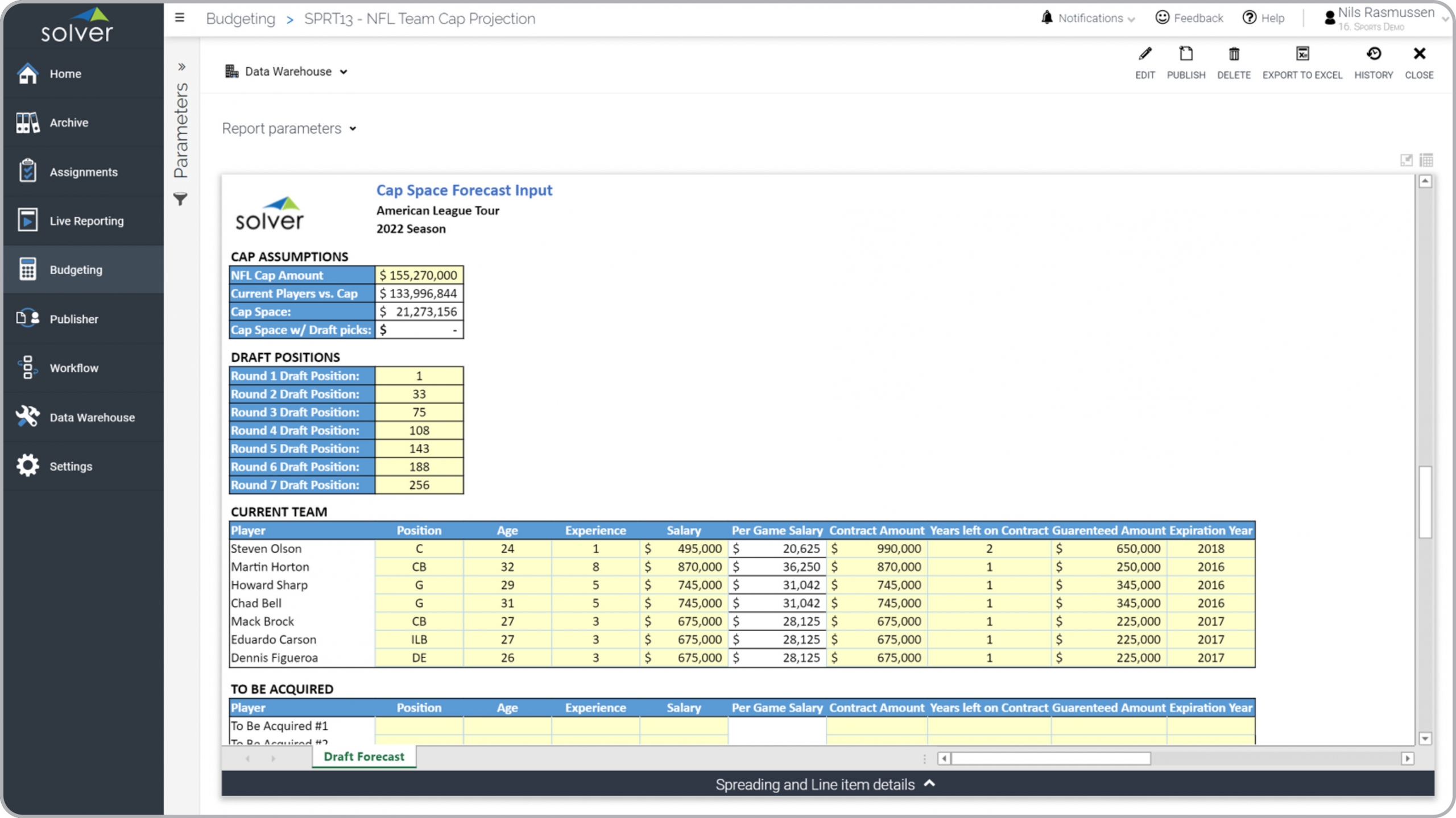Player Salary Budget for Professional Sports Teams
What is a
Team Player Salary Budget
? Player Salary Budgets are considered human capital planning models and are used by budget managers to allocate team cap funds to players' compensation packages. Some of the main functionality in this type of input form is that it starts with a number of assumptions and then uses these to allocate amounts to existing players and expected recruits. Examples of drivers are: Total team cap amount, current player costs versus team cap, and draft positions. Details per player can include: Position, age, experience, salary, contract amount, years left on contract, guaranteed amount, and expiration year. You find an example of this type of input form below.
Purpose of
Player Salary Budget Models Sports organizations use Player Salary Budget Models to easily model compensation for both existing players and those expected to be acquired. When used as part of good business practices in Financial Planning & Analysis (FP&A) departments, a professional team can improve its agility and speed during compensation negotiations, and it can reduce the chances that calculation errors distort budgets and tactics.
Example of a
Player Salary Budget Model Here is an example of a dynamic team player budget model with drivers and capture of key metrics. [caption id="" align="alignnone" width="2560"]
 Example of a Player Salary Budget for Professional Sports Teams[/caption] You can find hundreds of additional examples
here
Who Uses This Type of
Input form
? The typical users of this type of input form are: CFOs, recruiters, compensation negotiators, budget managers, owners.
Other Reports Often Used in Conjunction with
Player Salary Budget Models Progressive Financial Planning & Analysis (FP&A) departments sometimes use several different Player Salary Budget Models, along with team player dashboards, player statistical dashboards, historical salary reports, profit & loss reports, complete budget and forecast models and other management and control tools.
Where Does the Data for Analysis Originate From? The Actual (historical transactions) data typically comes from enterprise resource planning (ERP) systems like: Microsoft Dynamics 365 (D365) Finance, Microsoft Dynamics 365 Business Central (D365 BC), Microsoft Dynamics AX, Microsoft Dynamics NAV, Microsoft Dynamics GP, Microsoft Dynamics SL, Sage Intacct, Sage 100, Sage 300, Sage 500, Sage X3, SAP Business One, SAP ByDesign, Acumatica, Netsuite and others. In analyses where budgets or forecasts are used, the planning data most often originates from in-house Excel spreadsheet models or from professional corporate performance management (CPM/EPM) solutions.
What Tools are Typically used for Reporting, Planning and Dashboards? Examples of business software used with the data and ERPs mentioned above are:
Example of a Player Salary Budget for Professional Sports Teams[/caption] You can find hundreds of additional examples
here
Who Uses This Type of
Input form
? The typical users of this type of input form are: CFOs, recruiters, compensation negotiators, budget managers, owners.
Other Reports Often Used in Conjunction with
Player Salary Budget Models Progressive Financial Planning & Analysis (FP&A) departments sometimes use several different Player Salary Budget Models, along with team player dashboards, player statistical dashboards, historical salary reports, profit & loss reports, complete budget and forecast models and other management and control tools.
Where Does the Data for Analysis Originate From? The Actual (historical transactions) data typically comes from enterprise resource planning (ERP) systems like: Microsoft Dynamics 365 (D365) Finance, Microsoft Dynamics 365 Business Central (D365 BC), Microsoft Dynamics AX, Microsoft Dynamics NAV, Microsoft Dynamics GP, Microsoft Dynamics SL, Sage Intacct, Sage 100, Sage 300, Sage 500, Sage X3, SAP Business One, SAP ByDesign, Acumatica, Netsuite and others. In analyses where budgets or forecasts are used, the planning data most often originates from in-house Excel spreadsheet models or from professional corporate performance management (CPM/EPM) solutions.
What Tools are Typically used for Reporting, Planning and Dashboards? Examples of business software used with the data and ERPs mentioned above are:
- Native ERP report writers and query tools
- Spreadsheets (for example Microsoft Excel)
- Corporate Performance Management (CPM) tools (for example Solver)
- Dashboards (for example Microsoft Power BI and Tableau)
Corporate Performance Management (CPM) Cloud Solutions and More Examples
June 12, 2021
TAGS:
Reporting,
Solver,
NPSL,
report writer,
Microsoft,
NBA,
template,
practice,
Acumatica,
basketball,
league,
MLB,
Netsuite,
Finance,
planning,
GP,
Business Central,
excel,
professional,
assumption,
ax,
forecast,
Budget,
Dynamics 365,
budgeting,
professional sports,
payroll budget,
Cloud,
Software,
Tableau,
SAP,
compensation,
NRL,
example,
NHL,
NFL,
best,
Sage,
BC,
EPL,
D365,
MLS,
NAV,
Intacct,
soccer,
hockey,
baseball,
salary,
CPM,
report,
SL,
Management,
dynamics,
football,
Power BI,
player,
cap

